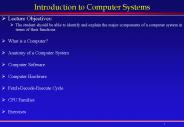Language and computer - PowerPoint PPT Presentation
1 / 12
Title: Language and computer
1
Language and computer
- Speech synthesis
- automatic generation of speech waveforms
- by computers
- Speech recognition
- automatic voice recognition by computers
- Machine translation
- the process that utilizes computer software
- to translate text from one natural language
- into another.
2
Speech synthesis
- Methods
- 1. Articulatory synthesis
- Articulatory synthesis tries to model the
human vocal organs as perfectly as possible. It
typically involves models of the human
articulators and vocal cords. - pro potentially most satisfying method to
produce high-quality - synthetic speech
- con most difficult to implement and the
computational load is - also considerably higher
- the movements of tongue are so
complicated that it is - almost impossible to model them
precisely.
3
Speech synthesis methods
- 2. Formant synthesis
- Formants resonant frequencies of the vocal
tract.
4
Speech synthesis formant
5
Speech synthesis methods
- 3. Concatenative synthesis
- Connecting prerecorded natural utterances
- pro most easy and natural way to synthesize
- con limited to one speaker and one voice
- require more memory space
- concatinative unit
- - words word boundary effect
- co-articulation
- - syllable co-articulation
- - diphone to extend the central
point of the steady state part - of the phone to
the central point of the following - one
6
Speech synthesis Text to Speech
- Text- to speech
- A Text-To-Speech (TTS) synthesizer is a
computer-based system that should be able to read
any text aloud, whether it was directly
introduced in the computer by an operator or
scanned and submitted to an Optical Character
Recognition (OCR) system.
7
Speech recognition
- Speech Recognition is a technology that
"listens to" and interprets users'
spokencommands. This allows the user to control
the computer (or certain aspects of it) by voice,
rather than having to use the mouse and keyboard,
or alternatively just dictating the contents of a
document.
8
Speech recognition
- Automatic speech recognition (ASR)
- Modern architectures for Automatic Speech
Recognition are mostly software architectures
generating a sequence of word hypotheses from an
acoustic signal. The most popular algorithms
implemented in these architectures are based on
statistical methods.
9
Machine translation
- Why do we need Machine Translation
- (MT)?
- to facilitate communication
- commercial importance
- scientific importance
- Philosophical importance
10
Machine translation
- MT is very hard translation programs available
today do not perform very well. - Different approaches to MT
- Word for Word
- Syntactic Transfer Approaches
- Semantic Transfer Approaches
- Interlingua
- Most MT systems are a mix of probabilistic and
non-probabilistic components, though there are a
few completely statistical translation systems.
11
Machine translation
- Text Alignment
- Align roughly parallel texts (e.g. short
sentences) - Word Alignment
- Use existing bilingual dictionaries to align
words. - Fully Statistical Attempt at MT
12
Useful links
- Speech synthesis
- http//www.research.att.com/ttsweb/cgi-bin/ttsdem
o - Machine translation
- http//babelfish.altavista.com/babelfish/tr
- IPA sounds
- http//www.ling.hf.ntnu.no/ipa/full/ipachart_cons_
pulm.html































